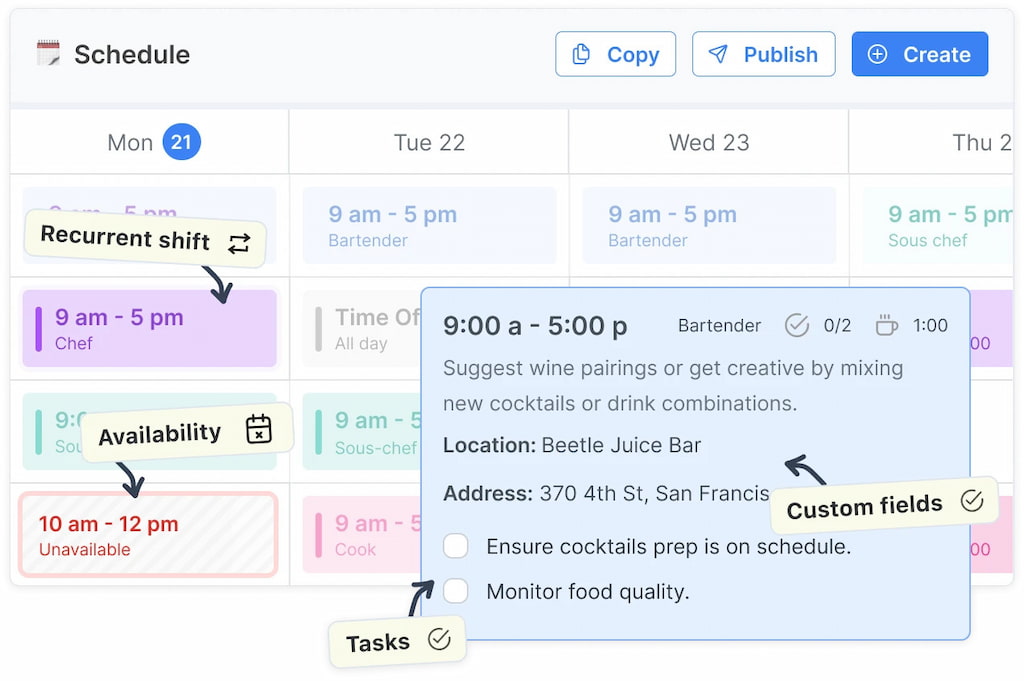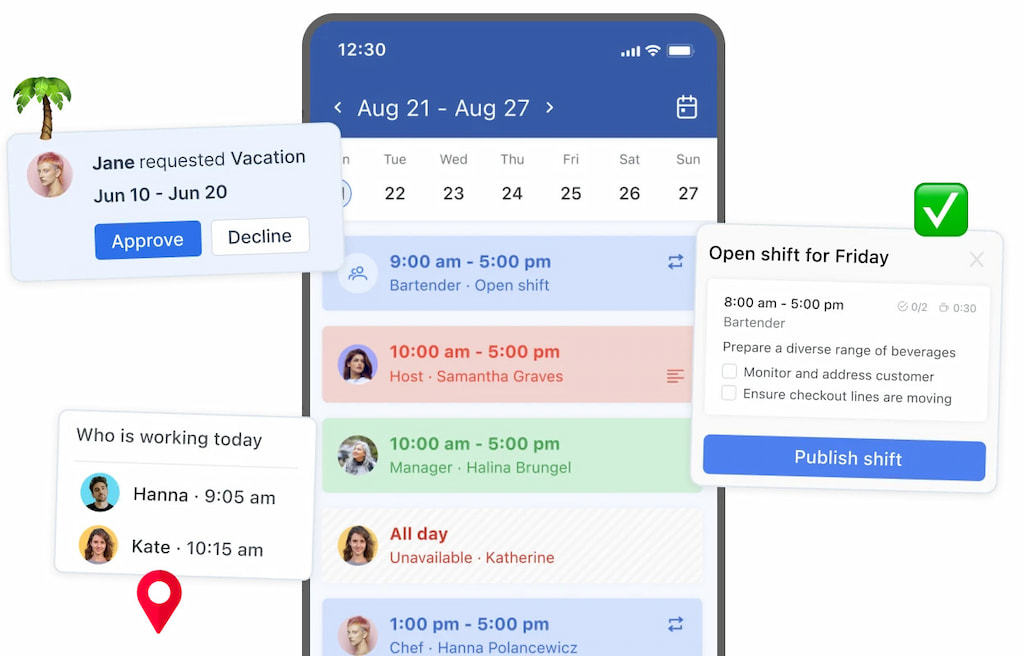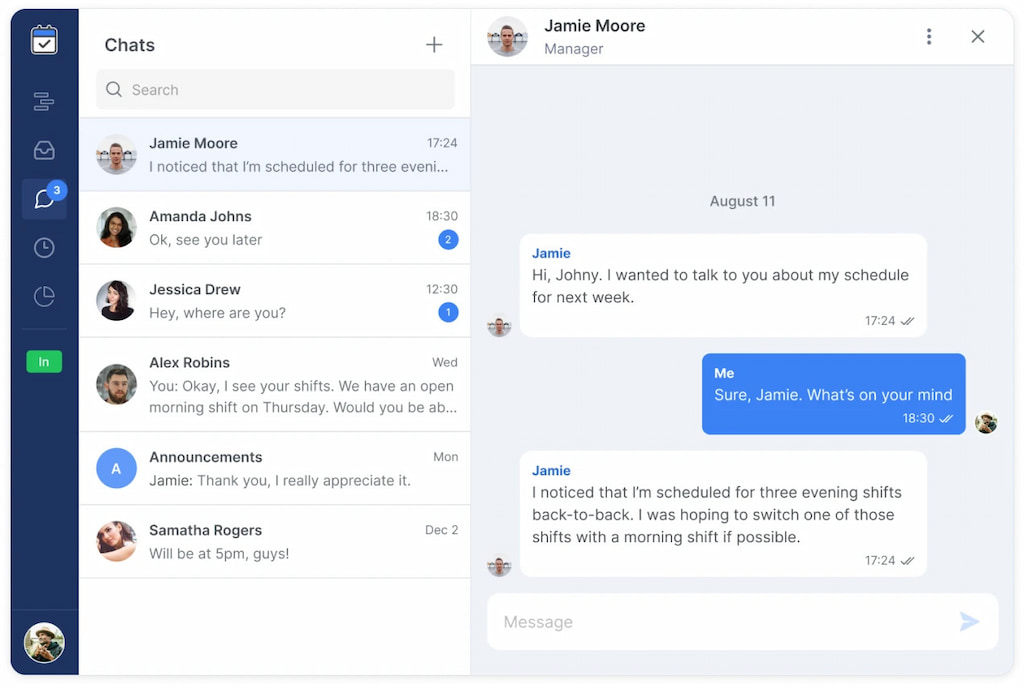Scheduling of Field Service Technicians and Engineers: Guide for Dispatchers, Ops Leaders, and Owners

Managing field teams of technicians and engineers can be challenging, especially when it comes to scheduling shifts, tracking work hours, and ensuring timely service delivery. That’s where scheduling of field service technicians and engineers comes in — a crucial tool for keeping your teams organized, reducing downtime, and improving customer satisfaction. With the right field service scheduling software, managers can assign jobs efficiently, handle last-minute changes, and maintain clear communication across dispersed teams, all while keeping operations running smoothly.
🌟 What is Scheduling for Field Service Technicians and Engineers
Scheduling for field service technicians and engineers is the process of planning and organizing work assignments, shifts, and travel for employees who operate outside a central office. The goal is to ensure the right technician or engineer is dispatched to the right job at the right time, improving efficiency and customer satisfaction.
Why it’s better than spreadsheets or ad-hoc methods
- ❌ Manual spreadsheets can cause errors, missed shifts, and poor visibility
- ✅ Scheduling software automates assignments, tracks availability, and provides real-time updates
- ✅ Prevents double-booking and simplifies managing multiple locations or urgent service requests
Core goals of effective scheduling
- ⚡ Efficiency: Minimize travel time, downtime, and conflicts
- 🗂️ Coverage: Ensure all jobs and shifts are properly assigned
- ⏱️ Timely service: Meet deadlines and response times to enhance customer satisfaction
With proper scheduling, managers can coordinate teams effectively, reduce operational stress, and deliver reliable service consistently.
🤔 Common Challenges in Field Service Scheduling
Scheduling field service technicians and engineers comes with unique hurdles that can impact efficiency, costs, and customer satisfaction. Some of the most common challenges include:
- ⏳ Managing last-minute job requests or cancellations: Urgent service calls or cancellations can disrupt the entire schedule if not handled quickly.
- 🗺️ Coordinating multi-location teams and travel time: Assigning the right technician while minimizing travel and downtime is tricky without a clear overview.
- ⚖️ Avoiding overtime and balancing workloads: Uneven distribution of shifts can lead to burnout, higher costs, and dissatisfied staff.
- 📜 Ensuring compliance with labor laws and certifications: Technicians must have the required qualifications, and schedules need to respect labor regulations.
Addressing these challenges requires smart field service scheduling tools and proactive planning to keep operations smooth and maintain high service quality.
🔧 Key Features of Field Service Scheduling Software
Effective field service scheduling software goes beyond simple calendars. It provides tools that help managers plan, track, and optimize their teams efficiently. Key features include:
- 🖱️ Shift planning and assignment: Quickly assign jobs or shifts to the right technicians based on skills, location, and availability.
- ⚡ Real-time notifications and updates: Alert technicians immediately about schedule changes, new jobs, or cancellations.
- ⏱️ Time tracking and attendance: Monitor clock-ins, clock-outs, and hours worked to improve accuracy and payroll management.
- 🛠️ Certification and qualification tracking: Ensure that only qualified technicians are scheduled for specialized tasks.
- 📊 Reporting and analytics: Gain insights into productivity, travel time, overtime, and labor costs to optimize future scheduling.
- 📱 Mobile accessibility: Allow technicians to access their schedules, report job status, and communicate with the team on the go.
✍️ Field Service Scheduling Software At a Glance
| Tool | Key Features | Pricing | Ideal For |
|---|---|---|---|
| Shifts by Everhour | Shift planning, open shifts, time tracking, mobile alerts | Free plan + paid tiers from ~$5/user/month | Small to mid field teams needing simple scheduling + tracking |
| ServiceTitan | Advanced scheduling, dispatch, job costing, mobile app | Custom quote | Large HVAC, plumbing, or electrical businesses |
| FieldAware | Job scheduling, mobile field app, analytics dashboard | Custom quote | Commercial field service operations |
| Jobber | Scheduling, dispatch, invoicing, client management | From ~$39/month | Small to medium service companies |
| Skedulo | Resource scheduling, mobile workforce, route planning | Custom quote | Mid-market field teams |
| Connecteam | Mobile scheduling, task management, chat tools | Free up to 50 users; paid from ~$29/month | Mobile-first field teams |
| When I Work | Shift scheduling, time tracking, shift swapping | From ~$2/user/month | Hourly teams on a budget |
| Humanity | Scheduling, attendance, multi-location support | From ~$4.50/user/month | Medium-size multi-site teams |
Tool highlights
- Shifts by Everhour: Combines scheduling and time tracking in a clean, easy‑to‑use platform perfect for smaller field service teams.
- ServiceTitan: High‑end solution with deep features for large service businesses needing full dispatch, job costing, and mobile field support.
- FieldAware: Built for commercial service industries, supports many use cases across field service, and offers strong mobile and reporting tools.
- Jobber: Affordable and intuitive scheduling + billing option ideal for smaller service businesses with simpler needs.
- Skedulo: Focused on resource optimization and mobile workforce management, great for mid‑market teams with complex scheduling.
- Connecteam: Mobile‑first scheduling and communication platform built for teams in the field, with task and schedule tools integrated.
- When I Work: Very budget‑friendly option for hourly field teams, offering core scheduling and mobile features at low cost.
- Humanity: Scalable scheduling for multi‑location or medium teams needing solid reporting and attendance features.
🔵 How Shifts by Everhour Helps Field Service Teams
Managing a field service team can be chaotic, but Shifts by Everhour simplifies scheduling and tracking so your team always knows what to do. Here’s how it helps:
- 🗓 Streamlined shift scheduling: Quickly assign shifts, create recurring schedules, and adjust coverage in seconds.

- ⏱ Time tracking and attendance: Track clock-ins, breaks, and hours worked automatically, eliminating manual timesheets.
- 📱 Mobile access: Technicians and engineers can view schedules, claim open shifts, and update availability on the go.

- 🔔 Real-time notifications: Staff get instant alerts about shift changes, open shifts, or cancellations.
- 🔄 Easy shift swaps and PTO management: Employees can request time off or swap shifts, while admins approve or decline with a click.
- 💬 Team communication: Built-in chat lets field workers coordinate without messy phone threads.

- 📊 Reports and analytics: Compare scheduled vs. actual hours and monitor team performance to optimize operations.
Example use case: A small HVAC company uses Shifts by Everhour to assign morning and afternoon routes, track technician hours on multiple jobs, and manage last-minute cancellations — all from a single app.
❓ FAQ: Scheduling of Field Service Technicians and Engineers
What is field service scheduling software?
It’s a tool that helps companies plan and assign jobs for technicians and engineers. It replaces manual spreadsheets and keeps schedules, routes, and updates in one place.
How does scheduling software help field teams?
It saves time, reduces mistakes, and helps teams handle last-minute changes. Managers can track jobs in real time, and technicians always know where they need to go next.
Can Shifts by Everhour be used for field service work?
Yes. Shifts by Everhour helps small and medium teams manage shifts, track hours, and stay connected — even when working in different locations.
What features should I look for in field service scheduling software?
Look for job assignment, route planning, mobile access, time tracking, and instant notifications. Integration with payroll or billing tools is also a plus.
How does Shifts by Everhour compare to other tools?
Tools like ServiceTitan or Jobber focus more on dispatch and invoicing. Shifts by Everhour is simpler and easier to use, making it great for teams that need clear scheduling and accurate time tracking.
🔎 Final Thoughts
Efficient scheduling keeps field service teams organized, productive, and ready to handle every job on time. The right software helps reduce errors, improve communication, and give both managers and technicians a clear picture of daily operations.
If you’re looking for a simple and reliable solution, Shifts by Everhour offers everything from shift planning to time tracking and mobile access — helping field teams stay on schedule and focused on great service.
It might be time to explore how Shifts by Everhour can streamline your field service scheduling and free you from manual chaos. It’s also a great free app for cleaning business and fire department scheduling, and many other industries (like security guard scheduling, for example)!
Streamline work-life balance with the 4-10 schedule — see how it works today!
